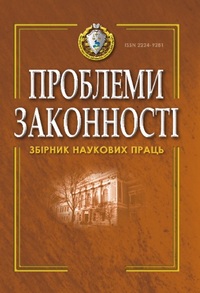Історико-порівняльний метод М. М. Ковалевського у контексті структурно-функціонального аналізу
«M. M. Kovalevsky’s historical and comparative method in the context of structural and functional analysis»
Author(s): D. ShygalSubject(s): Law, Constitution, Jurisprudence, History of Law
Published by: Національний юридичний університет імені Ярослава Мудрого
Keywords: method; historical and comparative; comparative; structure; theory; methods; technique
Summary/Abstract: Problem setting: Recent trends of the science of history of state and law development are convincing evidence of the urgent need to improve and put in order all the methodological arsenal that is used. Sometimes the question is raised more radically: historical and legal science immediately needs its own means of scientific knowledge. This is due to the fact that in modern research on historical and legal subject-matter, that is extremely complex, a scientist needs a qualitative methodological tools acting primarily as a guideline in the vast historical and legal space. Comparative historical and legal method is able to be one of those guidelines which main difference from other comparative means of scientific knowledge is a flexible combination of comparative, historical and legal approaches. Despite the fact that this method is qualitatively different from the comparative and historical, and comparative and legal ones they have development history in common. M. M. Kovalevsky is considered to be the scientist who made the most weighty contribution to the working out of that methodological tendency of legal science. The work of this pre-revolutionary researcher in the field of legal comparative study is so fruitful that still remains a subject of attention of various legal disciplines, including the history of state and law science. Recent research and publications analysis: A lot of prominent history scientists and lawyers have repeatedly focused on M. M. Kovalevsky’s historical and comparative method. Furthermore, M. A. Damirli, V. T. Zonov, O. V. Kresin, M. N. Marchenko, N. Nikolaenko, A. H. Saidov, A. O. Tille, E. O. Skrypilyov, I. M. Sytar, G. V. Shvekov and others are among them. At the same time, despite the coverage of the individual elements of M. M. Kovalevsky’s comparative method in the scientific literature, the holistic view of its structure and functions of each of its components is not formed yet. Appropriate research using structural and functional approach is required. Paper objective: The purpose of this scientific paper is the structural and functional analysis of M. M. Kovalevsky’s historical and comparative method by isolating its elements such as the theory, methodology and research technique. As a result, this should allow to debate about the importance of this way of knowledge for the development of law comparative study as the subject matter at hand. Paper main body: In his work «Historical and comparative method in jurisprudence and ways of studying the history of law» M. M. Kovalevsky seeks not only to prove the importance of comparative way of knowledge for research in the field of law, but also provides initial theoretical and methodological reasoning of the new method. In the context of structural and functional approach to the content of M. M. Kovalevsky’s historical and comparative method it is already possible to single out its necessary elements such as the theory, methods and research technique, indicating the scientist’s attempts to develop a certain concept of use of this means of knowledge. In particular, he reveals the theory of his method by setting tasks of building the history of progressive forms development for living together and studying the history of law of one nation or another and also through historical and comparative approaches to their solution. In M. M. Kovalevsky’s work we can also find the principles of the research objectives use which are the basis of his method theory. Methods and technique of historical and comparative analysis subject to the requirement to compare the largest possible number of objects, in the form of legislation, that should belong to peoples which are close in their social development, and are specified in the appropriate practical recommendations. In addition, M. M. Kovalevsky directly indicates the possibility for involving other methodological ways during the comparative analysis to obtain new facts. Conclusions of the research: Estimating the M. M. Kovalevsky’s efforts in the methodology of historical and legal comparative study it should be noted that the attitude to his method in the scientific community is controversial. While agreeing, in general, with a positive appreciation of the M. M. Kovalevsky’s scientific heritage it should be pointed that the scientist first qualitatively tried to develop theoretical and methodological basis for the historical and comparative method in the domestic comparative study. Despite the fact that while theoretically reasoning his own method, M. M. Kovalevsky lacked modern structural and functional approach, but in most cases he was able to aptly describe the individual elements of the theory, methods and technique of the new means of special and scientific knowledge.
Journal: Проблеми законності
- Issue Year: 2015
- Issue No: 131
- Page Range: 3-14
- Page Count: 12
- Language: Ukrainian

